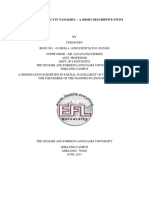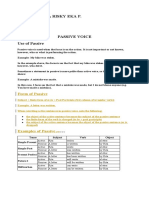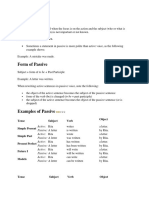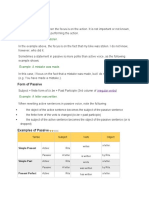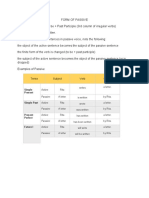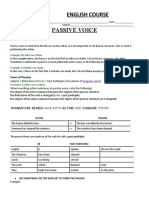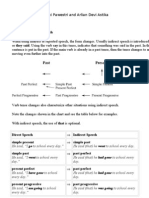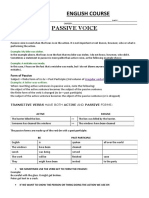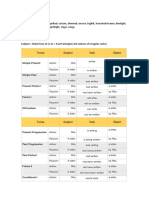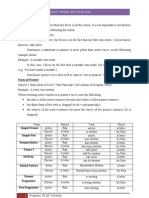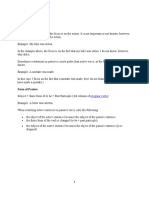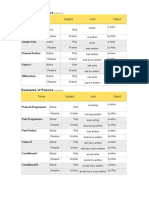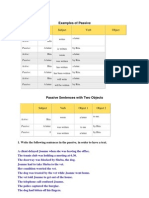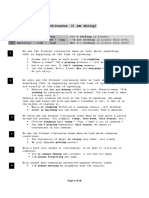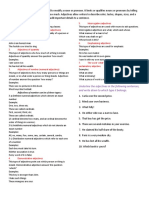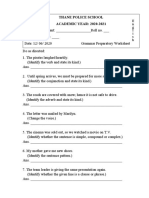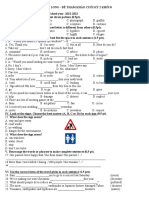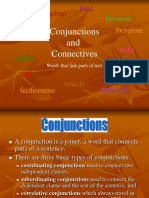Passive
Passive
Uploaded by
MagnoliaCopyright:
Available Formats
Passive
Passive
Uploaded by
MagnoliaOriginal Description:
Copyright
Available Formats
Share this document
Did you find this document useful?
Is this content inappropriate?
Copyright:
Available Formats
Passive
Passive
Uploaded by
MagnoliaCopyright:
Available Formats
Passive Voice
Language Guide German + Dictionary for iPhone and iPod-Touch (made by ego4u)
Exercises on Passive
Use of Passive
Passive voice is used when the focus is on the action. It is not important or not known, however, who or what
is performing the action.
Example: My bike was stolen.
In the example above, the focus is on the fact that my bike was stolen. I do not know, however, who did it.
Sometimes a statement in passive is more polite than active voice, as the following example shows:
Example: A mistake was made.
In this case, I focus on the fact that a mistake was made, but I do not blame anyone (e.g. You have made a
mistake.).
Form of Passive
Subject + finite form of to be + Past Participle (3rd column of irregular verbs)
Example: A letter was written.
When rewriting active sentences in passive voice, note the following:
the object of the active sentence becomes the subject of the passive sentence
the finite form of the verb is changed (to be + past participle)
the subject of the active sentence becomes the object of the passive sentence (or is dropped)
Examples of Passive
Tense Subject Verb Object
writes a letter.
Simple Present Active: Rita
Passive: A letter is written by Rita.
Simple Past Active: Rita wrote a letter.
Passive: A letter was written by Rita.
Present Perfect Active: Rita has written a letter.
Passive: A letter has been written by Rita.
Future I Active: Rita will write a letter.
Passive: A letter will be written by Rita.
Hilfsverben Active: Rita can write a letter.
Passive: A letter can be written by Rita.
Examples of Passive
Tense Subject Verb Object
is writing a letter.
Present Active: Rita
Progressive
Passive: A letter is being written by Rita.
Past Progressive Active: Rita was writing a letter.
Passive: A letter was being written by Rita.
Past Perfect Active: Rita had written a letter.
Passive: A letter had been written by Rita.
Future II Active: Rita will have written a letter.
Passive: A letter will have been written by Rita.
Conditional I Active: Rita would write a letter.
Passive: A letter would be written by Rita.
Conditional II Active: Rita would have written a letter.
Passive: A letter would have been written by Rita.
Passive Sentences with Two Objects
Rewriting an active sentence with two objects in passive voice means that one of the two objects becomes
the subject, the other one remains an object. Which object to transform into a subject depends on what you
want to put the focus on.
Subject Verb Object 1 Object 2
wrote a letter to me.
Active: Rita
Passive: A letter was written to me by Rita.
Passive: I was written a letter by Rita.
As you can see in the examples, adding by Rita does not sound very elegant. That’s why it is usually
dropped.
Personal and Impersonal Passive
Personal Passive simply means that the object of the active sentence becomes the subject of the passive
sentence. So every verb that needs an object (transitive verb) can form a personal passive.
Example: They build houses. – Houses are built.
Verbs without an object (intransitive verb) normally cannot form a personal passive sentence (as there is no
object that can become the subject of the passive sentence). If you want to use an intransitive verb in passive
voice, you need an impersonal construction – therefore this passive is called Impersonal Passive.
Example: he says – it is said
Impersonal Passive is not as common in English as in some other languages (e.g. German, Latin). In
English, Impersonal Passive is only possible with verbs of perception (e. g. say, think, know).
Example: They say that women live longer than men. – It is said that women live longer than men.
Although Impersonal Passive is possible here, Personal Passive is more common.
Example: They say that women live longer than men. – Women are said to live longer than men.
The subject of the subordinate clause (women) goes to the beginning of the sentence; the verb of perception
is put into passive voice. The rest of the sentence is added using an infinitive construction with 'to' (certain
auxiliary verbs and that are dropped).
Sometimes the term Personal Passive is used in English lessons if the indirect object of an active sentence is
to become the subject of the passive sentence.
You might also like
- Is Tense and Aspect Realised in TangkhulDocument33 pagesIs Tense and Aspect Realised in TangkhulovikbasuNo ratings yet
- The PassiveDocument3 pagesThe Passivelauralauralaura22No ratings yet
- Passive VoiceDocument2 pagesPassive VoicerachidswimmerNo ratings yet
- Nama: Salsa Risky Eka P. No: 28 Kelas: Ix-F Passive Voice Use of PassiveDocument3 pagesNama: Salsa Risky Eka P. No: 28 Kelas: Ix-F Passive Voice Use of PassiveNadia PrawiranegaraNo ratings yet
- Nama: Salsa Risky Eka P. No: 28 Kelas: Ix-F Passive Voice Use of PassiveDocument3 pagesNama: Salsa Risky Eka P. No: 28 Kelas: Ix-F Passive Voice Use of PassiveNadia PrawiranegaraNo ratings yet
- Passive Voice: Form of Passive Subject + Object + To Be + Past Participle + Verb 3Document3 pagesPassive Voice: Form of Passive Subject + Object + To Be + Past Participle + Verb 3SoniaNo ratings yet
- Passive Voice المبني للمجهولDocument3 pagesPassive Voice المبني للمجهولHussain K .NeamaNo ratings yet
- Passive SentencesDocument12 pagesPassive SentencesBAMSNo ratings yet
- Language Reference PASSIVE VOICE PDFDocument3 pagesLanguage Reference PASSIVE VOICE PDFmjoseNo ratings yet
- Use of Passive: Tense Subject Verb ObjectDocument2 pagesUse of Passive: Tense Subject Verb Objectreza rajabiNo ratings yet
- Passive Voice-Tag QuestionsDocument6 pagesPassive Voice-Tag QuestionsMilena Aguacia Moreno100% (1)
- Passive VoiceDocument7 pagesPassive VoiceAlice JaneNo ratings yet
- GRAMMAR BANK C1.1 Module 1: A) Passive VoiceDocument6 pagesGRAMMAR BANK C1.1 Module 1: A) Passive VoiceFátima Fuentes TávoraNo ratings yet
- Passive VoiceDocument5 pagesPassive VoiceDoryanna Frida IndapashaNo ratings yet
- Expressing Advisibility Using Should and Had BetterDocument6 pagesExpressing Advisibility Using Should and Had BetterDaniela PintroNo ratings yet
- 5th Class Inglés II Passive VoiceDocument5 pages5th Class Inglés II Passive VoiceGenesis RosalNo ratings yet
- Use of PassiveDocument6 pagesUse of Passiveashley.monsivaisNo ratings yet
- Passive Voice Class and ExercisesDocument7 pagesPassive Voice Class and Exercisesfkouablan7No ratings yet
- Tense Subject Verb Object: Simple PresentDocument4 pagesTense Subject Verb Object: Simple Presentfika cyNo ratings yet
- EnglishhhhhDocument2 pagesEnglishhhhhAlexutzuletzuNo ratings yet
- Passive Voice (1) AiDocument5 pagesPassive Voice (1) AiHaydee CardozaHuimanNo ratings yet
- English Grammar Notes: Active Voice To Passive VoiceDocument1 pageEnglish Grammar Notes: Active Voice To Passive VoiceenesusNo ratings yet
- Use of Passive-WPS OfficeDocument4 pagesUse of Passive-WPS OfficeRizki 1708No ratings yet
- Passive Voice (1) A IIDocument7 pagesPassive Voice (1) A IIHaydee CardozaHuimanNo ratings yet
- Passive VoiceDocument8 pagesPassive VoiceHaydee CardozaHuimanNo ratings yet
- Passive Voice (1) ADocument8 pagesPassive Voice (1) AHaydee CardozaHuimanNo ratings yet
- Examples of Passive: Tense Subject Verb ObjectDocument2 pagesExamples of Passive: Tense Subject Verb ObjectMacky babsNo ratings yet
- Learn English - Passive Voice - English Grammar - 1603100954565Document4 pagesLearn English - Passive Voice - English Grammar - 1603100954565LikeNo ratings yet
- Contoh Kalimat Active Dan Passive VoiceDocument5 pagesContoh Kalimat Active Dan Passive VoiceYuka SetianaNo ratings yet
- Passive Voice Explanation and ExcercisesDocument4 pagesPassive Voice Explanation and ExcercisesDiego Orlando Espinoza SotoNo ratings yet
- Direct and Indirect SpeechDocument9 pagesDirect and Indirect SpeechYuli SetiawanNo ratings yet
- APUNTES UNIT 1 - Puente de Mando - GrammarDocument5 pagesAPUNTES UNIT 1 - Puente de Mando - GrammarRODRÍGUEZ Álvaro NazarenoNo ratings yet
- Use of Passive: Example: My Bike Was StolenDocument6 pagesUse of Passive: Example: My Bike Was StolenTrâm Nguyễn Trần QuếNo ratings yet
- Passive Voice 1257739713 Phpapp01Document6 pagesPassive Voice 1257739713 Phpapp01Abiyyu AhmadNo ratings yet
- Surat Siaran Bil. 10 - 2018Document4 pagesSurat Siaran Bil. 10 - 2018anon_9160914No ratings yet
- English C1.1Document54 pagesEnglish C1.1manjbelpiNo ratings yet
- English Course Passive VoiceDocument8 pagesEnglish Course Passive VoiceEmily GonzalesNo ratings yet
- UNIT 3 Actividades Passive Voice 5 SemDocument8 pagesUNIT 3 Actividades Passive Voice 5 SemLeslie OrtegaNo ratings yet
- Vocabulary: Simple PresentDocument2 pagesVocabulary: Simple PresentByAleexNo ratings yet
- Tense Subject Verb Object: Simple PresentDocument3 pagesTense Subject Verb Object: Simple PresentERIK RAMIREZNo ratings yet
- Active Passive Tense ListDocument1 pageActive Passive Tense ListNazlıcan ŞEKERNo ratings yet
- Examples of Passive: Tense Subject Verb Object Simple Present Simple Past Present Perfect Future I HilfsverbenDocument2 pagesExamples of Passive: Tense Subject Verb Object Simple Present Simple Past Present Perfect Future I HilfsverbenandrafitrianNo ratings yet
- Active Passive Theory and ExerciseDocument13 pagesActive Passive Theory and ExerciseJw Yulianto100% (1)
- Passive VoiceDocument4 pagesPassive VoiceBriseida VillanuevaNo ratings yet
- Example: My Bike Was Stolen.: Passive Voice Use of PassiveDocument3 pagesExample: My Bike Was Stolen.: Passive Voice Use of PassivelucianapossasNo ratings yet
- Instituto Técnico Comercial Restrepo: English Guide Number 3 Level: EleventhDocument20 pagesInstituto Técnico Comercial Restrepo: English Guide Number 3 Level: EleventhErikNo ratings yet
- Passive Voice Use of Passive: Irregular VerbsDocument5 pagesPassive Voice Use of Passive: Irregular VerbsMilena MomirovićNo ratings yet
- Passive Voic2Document7 pagesPassive Voic2BRENDANo ratings yet
- Examples of Passive: Tense Subject Verb ObjectDocument2 pagesExamples of Passive: Tense Subject Verb ObjectPâmela MachadoNo ratings yet
- Examples of PassiveDocument1 pageExamples of PassiveteresabarbosaNo ratings yet
- Arranged by Nurul Aulia XIII-I Chemical Analysis: English MaterialDocument16 pagesArranged by Nurul Aulia XIII-I Chemical Analysis: English MaterialNurul LiaNo ratings yet
- Sintesis Once Periodo CuartoDocument5 pagesSintesis Once Periodo CuartoJonathan MussoliniNo ratings yet
- Examples of PassiveDocument1 pageExamples of Passiveanalucia797No ratings yet
- Simple Present: Tense Subject Verb ObjectDocument2 pagesSimple Present: Tense Subject Verb ObjectЕлвира ЧенковаNo ratings yet
- Class # 12Document7 pagesClass # 12FernandoNo ratings yet
- Active Passive VoiceDocument3 pagesActive Passive VoiceKamesh Eshwar100% (2)
- Passive VoiceDocument2 pagesPassive Voiceelmonolon2.0musicNo ratings yet
- Passivevoice (1) 2Document8 pagesPassivevoice (1) 2Sandra Sánchez PérezNo ratings yet
- Unit 9 Present Passive Voice, Past Passive Voice, Phrasal VerbsDocument13 pagesUnit 9 Present Passive Voice, Past Passive Voice, Phrasal VerbsTiền NguyễnNo ratings yet
- Double ConsonantsDocument4 pagesDouble ConsonantsAdriano BulhoesNo ratings yet
- (Book 2) Paragraph Writing - Supplementary BookDocument101 pages(Book 2) Paragraph Writing - Supplementary Booknguyenducduy040678No ratings yet
- English 1Document18 pagesEnglish 1islam hamdyNo ratings yet
- Chapter 19 - Language and Social VariationDocument10 pagesChapter 19 - Language and Social VariationHussain K .Neama100% (3)
- 2.helping Struggling ReadersDocument7 pages2.helping Struggling ReadersNurilMardatilaNo ratings yet
- Task-Based Language TeachingDocument14 pagesTask-Based Language TeachingDian Gusni HartatiNo ratings yet
- En Listening c1 ExamsheetDocument4 pagesEn Listening c1 ExamsheetIrynaNo ratings yet
- Script Relativity in Psycholinguistics and Sociolinguistics: Writing Systems As A Catalyst For Cognition and CultureDocument20 pagesScript Relativity in Psycholinguistics and Sociolinguistics: Writing Systems As A Catalyst For Cognition and CultureGlobal Research and Development ServicesNo ratings yet
- Adjective: Underline The Adjectives in The Following Sentences, and Write Down To Which Type It BelongsDocument1 pageAdjective: Underline The Adjectives in The Following Sentences, and Write Down To Which Type It BelongsBeverly Cartago100% (1)
- Syntax (Phrases and Clauses)Document26 pagesSyntax (Phrases and Clauses)Sammie sanaoNo ratings yet
- Class 8-English Worksheet (12.06.2020)Document3 pagesClass 8-English Worksheet (12.06.2020)ddddNo ratings yet
- Discoursal Construction of Writer Identities and The Teaching of WritingDocument13 pagesDiscoursal Construction of Writer Identities and The Teaching of Writingvio281No ratings yet
- 3. HVL-khối 8 2nd semesterDocument7 pages3. HVL-khối 8 2nd semesterKiều NguyễnNo ratings yet
- Cdi4 CoursepackDocument55 pagesCdi4 CoursepackRamil DonigNo ratings yet
- Japanese For DummiesDocument96 pagesJapanese For DummiesZuka Deaddoll89% (9)
- Identify The Phrase TypeDocument7 pagesIdentify The Phrase TypeArika WiraNo ratings yet
- French Student Handbook (Autumn 2022)Document21 pagesFrench Student Handbook (Autumn 2022)sadasdasNo ratings yet
- English Grammar Prefix and Suffix Worksheets Grade 5 OlympiadDocument2 pagesEnglish Grammar Prefix and Suffix Worksheets Grade 5 OlympiadSuvashreePradhan100% (1)
- Der Die DasDocument6 pagesDer Die DasChockalingam Chidambaram100% (1)
- Introducing Genre and English For Specific Purposes - Chapter 2 Analyzing Genre Moves - Sunny Hyon 2018Document16 pagesIntroducing Genre and English For Specific Purposes - Chapter 2 Analyzing Genre Moves - Sunny Hyon 2018ileana.luqueNo ratings yet
- ConjunctionDocument8 pagesConjunctionPan Siew YiengNo ratings yet
- Unit 2, From Reference - HandoutDocument56 pagesUnit 2, From Reference - HandoutThu VânnNo ratings yet
- Expression Purpose Reason ResultDocument10 pagesExpression Purpose Reason ResultYudhistira LazuardiNo ratings yet
- English Morphology - Notes PDFDocument83 pagesEnglish Morphology - Notes PDFGeorge Petre100% (4)
- ILM English Book1 Lesson 1Document6 pagesILM English Book1 Lesson 1Sakina BazarNo ratings yet
- english-for-kids-elementary-review-6-british-english-teacher-A1-A2Document9 pagesenglish-for-kids-elementary-review-6-british-english-teacher-A1-A2Lê Trang LyNo ratings yet
- Pronouns and PossesivesDocument35 pagesPronouns and PossesivesAlfredo AmbrocioNo ratings yet
- Unit 19-20 PDFDocument10 pagesUnit 19-20 PDFMuhammad MidhatNo ratings yet
- Reported SpeechDocument7 pagesReported SpeechNicolas diego LopezNo ratings yet
